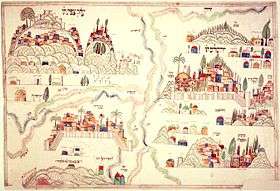Four Holy Cities

Nineteenth-century out-of scale map of Judaism's four holy cities, with Jerusalem occupying the upper right quadrant, Hebron beneath it, the Jordan River running top to bottom, Safed in the top left quadrant, and Tiberias beneath it. Each of the four cities includes representations of the sacred shrines, as well as the graves of sainted rabbis and holy men.
The Four Holy Cities (Hebrew: ארבע ערי הקודש, Yiddish: פיר רוס שטעט) is the collective term in Jewish tradition applied to the cities of Jerusalem, Hebron, Safed and, later, Tiberias, the four main centers of Jewish life after the Ottoman conquest of Israel.[1] The "holy cities" concept dates to the 1640s,[1] with Tiberias joining in 1740,[1] resulting from the creation of an association between the cities for the collection of halukka (funds for the needy).
According to the 1906 Jewish Encyclopedia: "Since the sixteenth century the Holiness of Palestine, especially for burial, has been almost wholly transferred to four cities—Jerusalem, Hebron, Tiberias, and Safed."[2]
- Jerusalem has been the holiest city in Judaism and the spiritual center of the Jewish people since the 10th century BC when the site was chosen during the lifetime of King David to be the location of the Holy Temple.[3]
- Hebron is the burial place of the Jewish patriarchs: Abraham and Sarah, Isaac and Rebecca and Jacob and Leah (Cave of the Patriarchs). As such Hebron is the second holiest city to Jews, and is one of the three cities where Israelite biblical figures purchased land (Abraham bought a field and a cave east of Hebron from the Hittites (Genesis 23:16-18), King David bought a threshing floor at Jerusalem from the Jebusite Araunah (2 Samuel 24:24), and Jacob bought land outside the walls of Shechem from the Shechemites (Genesis 33:18-19)). Historically, Hebron is the first capital of King David.
- Safed (Tz'fat) came to be regarded as a holy city after the influx of Jews following the expulsion of Jews from Spain in 1492 and became known as a center of kabbalistic scholarship.
- Tiberias was significant in Jewish history as the place where the Jerusalem Talmud was composed and as the home of the Masoretes, but its status as a holy city is due to the influx of rabbis who established the city as a center for Jewish learning in the 18th and 19th centuries. According to Jewish tradition, the redemption will begin in Tiberias and the Sanhedrin will be reconstituted there.[4] The Messiah will arise from the lake of Tiberias, enter into the city, and be enthroned at Safed on the summit of a lofty hill.[5]
See also
- Holy of Holies
- Jerusalem in Judaism
- Laws and customs of the Land of Israel in Judaism
- Old Yishuv - the Jewish communities established in the Land of Israel before the advent of modern political Zionism
- Temple in Jerusalem
References
- 1 2 3 Wigoder, Geoffrey, ed. (1989). The Encyclopedia of Judaism. Macmillan. p. 768.
Term applied to the Erets Israel cities of Jerusalem, Hebron, Safed and Tiberias. These were the four main centers of Jewish life after the Ottoman conquest of 1516. The concept of the holy cities dates only from the 1640s, when the Jewish communities of Jerusalem, Hebron, and Safed organized an association to improve the system of fundraising in the Diaspora. Previously, such fundraising had been undertaken by individual institutions; now it was agreed that the emissaries would be sent on behalf of each urban Jewish community as a whole, with not more than one emissary per town. After Tiberias was refounded in 1740, it also joined the association. This arrangement did not last long, however, and by the mid-19th century there was no authority strong enough to enforce a centralized collection of ḥalukkah funds. The term "Four Holy Cities" became a convenient designation by historians rather than the title of an actual functioning body. In Jewish tradition, going back to ancient times, the only city regarded as holy is Jerusalem
- ↑ Palestine, Holiness Of by Joseph Jacobs, Judah David Eisenstein. Jewish Encyclopedia, 1906 ed.
- ↑ Why Do Jews Love Jerusalem? by Yeruchem Eilfort. Chabad.org/ Ideas & Beliefs/Questions & Answers/Mitzvot & Jewish Customs
- ↑ Dov Noy; Dan Ben-Amos; Ellen Frankel (November 2006). Folktales of the Jews: Tales from the Sephardic dispersion. Jewish Publication Society. p. 66. ISBN 978-0-8276-0829-0. Retrieved 17 October 2010.
- ↑ Henry W. Bellows (2008). The Old World in Its New Face: Impressions of Europe in 1867-1868, Volume II. BiblioBazaar, LLC. p. 337. ISBN 978-0-559-64379-8. Retrieved 17 October 2010.
This article is issued from
Wikipedia.
The text is licensed under Creative Commons - Attribution - Sharealike.
Additional terms may apply for the media files.